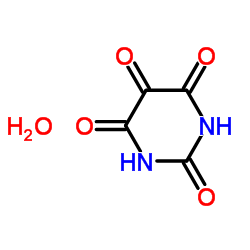Pyrimidine-2,4,5,6(1H,3H)-tetraone hydrate

Pyrimidine-2,4,5,6(1H,3H)-tetraone hydrate structure
|
Common Name | Pyrimidine-2,4,5,6(1H,3H)-tetraone hydrate | ||
|---|---|---|---|---|
| CAS Number | 2244-11-3 | Molecular Weight | 160.085 | |
| Density | 1.681g/cm3 | Boiling Point | 374.1ºC at 760 mmHg | |
| Molecular Formula | C4H4N2O5 | Melting Point | 255 °C (dec.)(lit.) | |
| MSDS | Chinese USA | Flash Point | 180ºC | |
| Symbol |

GHS07 |
Signal Word | Warning | |
Use of Pyrimidine-2,4,5,6(1H,3H)-tetraone hydrateAlloxan hydrate is a diabetogenic agent to induce diabetes. Alloxan hydrate is a proteasome inhibitor. Alloxan causes diabetes in experimental animals through its ability to destroy the insulin-secreting B-cells of the pancreas[1][2]. |
| Name | Alloxan monohydrate |
|---|---|
| Synonym | More Synonyms |
| Description | Alloxan hydrate is a diabetogenic agent to induce diabetes. Alloxan hydrate is a proteasome inhibitor. Alloxan causes diabetes in experimental animals through its ability to destroy the insulin-secreting B-cells of the pancreas[1][2]. |
|---|---|
| Related Catalog | |
| In Vitro | Alloxan hydrate inhibits the peptidase activities of the purified 26S and 20S proteasomes[1]. |
| References |
| Density | 1.681g/cm3 |
|---|---|
| Boiling Point | 374.1ºC at 760 mmHg |
| Melting Point | 255 °C (dec.)(lit.) |
| Molecular Formula | C4H4N2O5 |
| Molecular Weight | 160.085 |
| Flash Point | 180ºC |
| Exact Mass | 160.012024 |
| PSA | 115.73000 |
| Vapour Pressure | 8.59E-07mmHg at 25°C |
| Storage condition | 2-8°C |
| Water Solubility | H2O: may be hazy yellow |
CHEMICAL IDENTIFICATION
HEALTH HAZARD DATAACUTE TOXICITY DATA
MUTATION DATA
|
| Symbol |

GHS07 |
|---|---|
| Signal Word | Warning |
| Hazard Statements | H302 + H312 + H332 |
| Precautionary Statements | P280 |
| Personal Protective Equipment | dust mask type N95 (US);Eyeshields;Gloves |
| Hazard Codes | Xn:Harmful; |
| Risk Phrases | R20/21/22 |
| Safety Phrases | S36 |
| RIDADR | NONH for all modes of transport |
| WGK Germany | 3 |
| RTECS | UW0492000 |
| HS Code | 29335995 |
| Precursor 0 | |
|---|---|
| DownStream 2 | |
| HS Code | 2933599090 |
|---|---|
| Summary | 2933599090. other compounds containing a pyrimidine ring (whether or not hydrogenated) or piperazine ring in the structure. VAT:17.0%. Tax rebate rate:13.0%. . MFN tariff:6.5%. General tariff:20.0% |
|
Translating clinical findings into knowledge in drug safety evaluation--drug induced liver injury prediction system (DILIps).
J. Sci. Ind. Res. 65(10) , 808, (2006) Drug-induced liver injury (DILI) is a significant concern in drug development due to the poor concordance between preclinical and clinical findings of liver toxicity. We hypothesized that the DILI typ... |
|
|
Developing structure-activity relationships for the prediction of hepatotoxicity.
Chem. Res. Toxicol. 23 , 1215-22, (2010) Drug-induced liver injury is a major issue of concern and has led to the withdrawal of a significant number of marketed drugs. An understanding of structure-activity relationships (SARs) of chemicals ... |
|
|
A predictive ligand-based Bayesian model for human drug-induced liver injury.
Drug Metab. Dispos. 38 , 2302-8, (2010) Drug-induced liver injury (DILI) is one of the most important reasons for drug development failure at both preapproval and postapproval stages. There has been increased interest in developing predicti... |
| Mesoxalylcarbamide monohydrate |
| 2,4,5,6-Tetraoxohexahydropyrimidine hydrate |
| MFCD00149399 |
| 2,4,5,6-Tetraoxypyrimidine |
| 2,4,5,6(1H,3H)-Pyrimidinetetrone hydrate |
| alloxan hydrate |
| 2,4,5,6(1H,3H)-Pyrimidinetetrone hydrate (1:1) |
| ALLOXAN MONOHYDRATE |
| alloxane monohydrate |
| 1,3-dihydropyrimidine-2,4,5,6-tetraone,hydrate |
| 2,4,5,6(1H,3H)-Pyrimidinetetrone, hydrate (1:1) |
| Alloxan-monohydrat |
| 5,6-Dioxyuracil |
| alloxane hydrate |
| Alloxan,monohydrate |
| Pyrimidine-2,4,5,6(1H,3H)-tetraone hydrate |
| EINECS 251-501-8 |
| Pyrimidine-2,4,5,6(1H,3H)-tetrone hydrate (1:1) |
 CAS#:76002-68-1
CAS#:76002-68-1![Benzo[g]pteridine-2,4(3H,10H)-dione, 10-dodecyl- structure](https://www.chemsrc.com/caspic/072/79828-16-3.png) CAS#:79828-16-3
CAS#:79828-16-3
